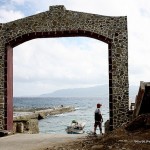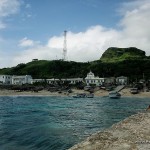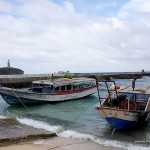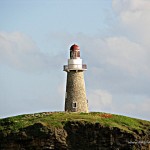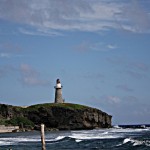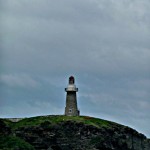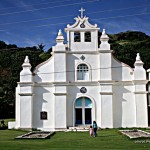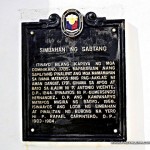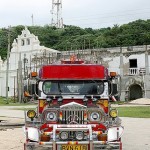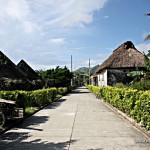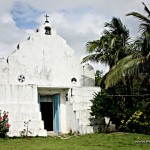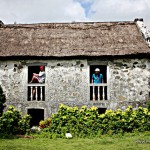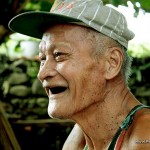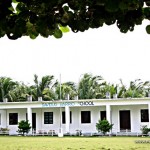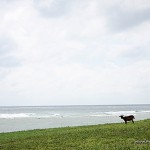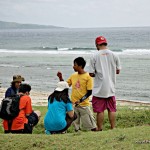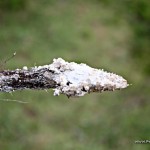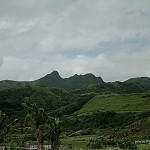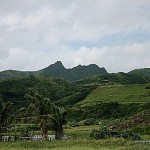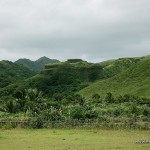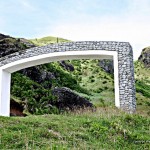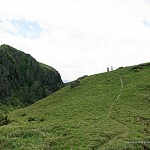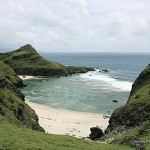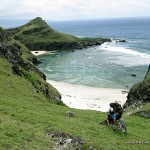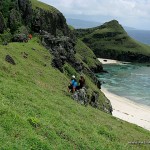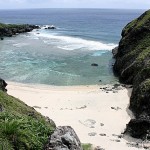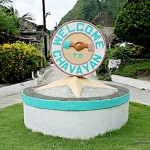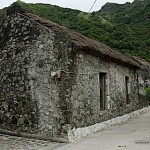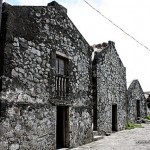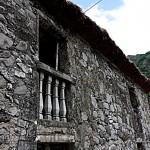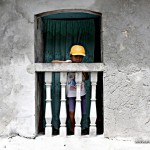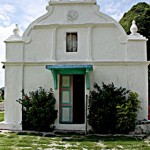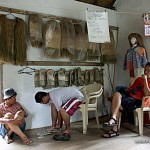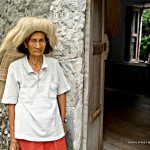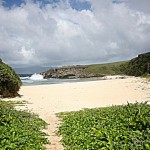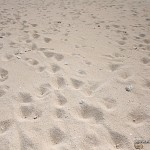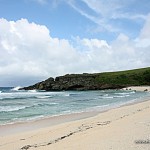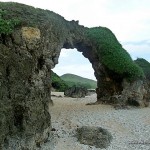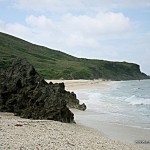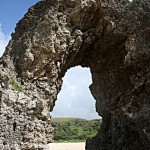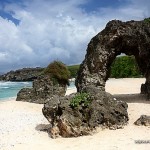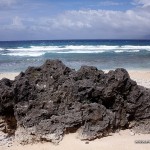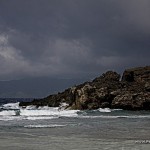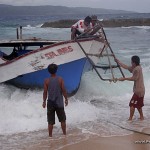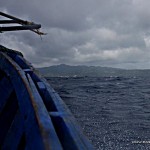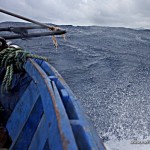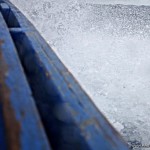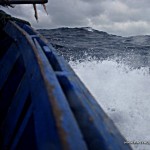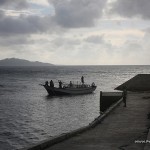On our third day in Batanes, we woke up early and got ready for our Sabtang island tour. Sabtang is an island municipality across Batan and is a 45-minute falowa (banca without outriggers) ride away from the port of Ivana. In 1994, Sabtang has been chosen by the Philippine Department of Tourism as one of the 12 best destinations in the country.
Another couple, Elsie and Mark, whom we met at the airport and also stayed in Batanes Resort, have decided to join us on our trip. Nice. (This means we can save a few bucks on the island tour.) We left the resort at around 6.15 a.m. then took a tricycle and headed to the port of Ivana. As we arrived, we found out that the falowa was ready to leave and was just waiting for us. We hurriedly jumped inside the boat, wore our life vests and headed to Sabtang island.
The falowa ride to Sabtang can get really quite rough but our 45-minute ride was smooth, comfortable and was very fast. The winds were light. The sea was calm. The sun was out. The weather was just perfect for our whole day tour.
Unlike Batan, Sabtang is less populated and it is the only town in Batanes that has preserved the traditional Ivatan stone houses. It is subdivided into six (6) villages or barangays which includes Chavayan, Malakdang, Nakanmuan, Savidug, Sinakan and Sumnanga.
As we reached the port of San Vicente, we were greeted by the arch on the island and we’re also lucky to have been welcomed by the town’s mayor. While our tour guide, Kuya Nards, was looking for a jeep to be rented, we started to walk around the place.
Sabtang Lighthouse
This is one of the many structures that can be found with in the island. It is located on top of a rocky hill in Sabtang and can be seen from the port of San Vicente.
San Vicente Ferrer Church
This is one of the first tourist attractions that you will see in Sabtang. It was patterned after the church in Basco and was built of espadaña-style facade by the Dominican missionaries in 1844. The church was located near the municipal hall and the elementary school, which can be found on the north-eastern part of the island called “Centro.”
After walking around the area, we went back to the port to have our breakfast at Pananayan Canteen which was owned by Pedro “Pending” Elesterio. After eating, we began with our tour. We hired a jeep for Php 1,500 that drove us around the island.
Bario Savidug
This small town is one of the traditional villages in Sabtang and is considered to be one of the unique attractions in the island. It comprises a long row of centuries-old lime and stone houses with roofs made of cogon grasses. These traditional stone houses are built and designed to withstand the battering of typhoons.
Lime Beach
On our way Chamantad-Tinyan Sitio, we stopped by a beach known as the “Lime Beach.” This is the beach where the Ivatans make the lime that they use to bind stones together when building stone houses.
Sleeping Beauty
Just across the road, Kuya Nards pointed out the mountain ranges which resemble the profile of a sleeping woman when viewed from afar.
Savidug Idjang
Fronting the “Sleeping Beauty” lies the pre-Hispanic ruin of an Idjang (stone fortress.) This hilltop fortress served as a refuge and settlement for the ancient Ivatans during tribal conflicts.
Chamantad-Tinyan Sitio
This is one of the best places in Sabtang. You need to trek around the hills and the mountains for you to have a better panoramic view of the coasts of Sabtang. The view of the beach located just below the mountain was a perfect and stunning view. You should, however, be very careful when climbing the hills since the winds here can be very, very strong.
Chavayan Village
Visiting the town of Chavayan is another highlight of the tour. This beautiful town has been known for its preservation and protection. Chavayan is also renowned as a center for vakul weaving. “Vakul” is a headgear made out of Philippine Date Palm or Voyavoy leaves which is used to protect the Ivatans from rain, wind and sun. Vakuls are worn by women whereas the “Talugongs” are worn by Ivatan men.
After these, we went back to San Vicente port to have our lunch at Pananayan Canteen. The foods they served for the price of Php 250 per head were delectable and mouth-watering: turmeric rice (yellow rice,) “tatus” or coconut crabs, lobsters, Spanish mackerel and veggies served with fresh buko juice.
I apologize that I forgot to take some pictures of the food that was served. I had been very excited that I ate them right away.
Nakabuang Beach and Arc
Our last stop on the island was the Nakabuang Beach also known as the “White Beach.” This beach is famous for its natural rock arc formation. We didn’t have enough time to swim so we just took some pictures of the breath taking sceneries along the beach.
It was already drizzling when we left the beach. The sky gradually turned dark then the wind started to blow harder. It’s as if a typhoon is coming.
We headed to San Vicente port to catch the boat back to Batan. Unfortunately, the boatmen told us that they won’t be sailing since the weather is not good and that the waves are already getting bigger. Elsie and Mark got worried since their flight bound to Manila would be on the next day. They decided to hire the falowa for the price of Php 1,500 (which were then divided among the five of us.) The boatmen, after so much of conversation and negotiation made, finally agreed.
We left San Vicente port past 3 p.m. and the short crossing from Sabtang to Batan had been very rough. Our boat was hitting waves and slamming us back down into the water. For more than an hour, we were being slammed around by huge rolling waves. One moment, we can see Batan island, one moment, it’s gone since it has been covered by 10 to 15-foot high waves. I was enjoying the whole ride but at the same time, I was screaming, screaming so hard while Icey was busy laughing at me. In the middle of our ride, our friend, Al, felt dizzy and even “fed the fishes” with his lunch. As we approached Ivana port, the sea became calm but the sky remained dark. We were all dripping wet when we docked at the port around 5 p.m.
We took a jeep ride on our way back to Batanes Resort and then capped off a great day. All in all, our whole experience was fantastic and was really worth all the hassle.

